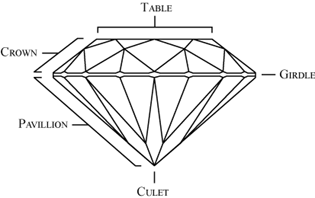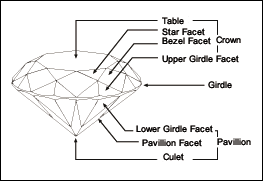CARAT
The
Larger a Diamond, the More Rare Larger
diamonds are found relatively infrequently in nature, which places them at the
rarest level of the Diamond Quality Pyramid. What also makes a bigger diamond
so desirable is that it shows off a stone's fine color and cut, and therefore
its brilliance, to its best advantage.
A
diamond's size is measured in carat weight, and each carat is equal to 100 points.
A .75 carat diamond is the same as a 75-point diamond or a 3/4 carat stone.
While
larger diamonds are highly prized, diamonds of equal size may vary widely in value
and brilliance, depending on their qualities of clarity, cut, and color.
CLARITY
The
Purer a Diamond, the More Brilliant
The
greater a diamond's clarity, the more brilliant, valuable and rare it is -- and
the higher it is on the Diamond Quality Pyramid.
Virtually
all natural diamonds contain identifying characteristics, yet many are invisible
to the naked eye. Under the scrutiny of a jeweler's 10x-magnifying loupe or microscope,
natural phenomena -- called inclusions -- may be seen. These are nature's birthmarks,
and they may look like tiny crystals, clouds, or feathers.
Diamonds
categorized as internally flawless reveal no such inclusions. Flawless stones
are at the peak of the Diamond Quality Pyramid and are treasured for their rarity
and beauty. Diamonds with very, very small inclusions are graded as VVS1 or VVS2.
The larger the inclusion, the lower the grade and the less rare the diamond. Inclusions
that can be seen with the naked eye are graded I1 to I3.
The
number, color, type, size and position of surface and internal birthmarks affect
a diamond's value. Major inclusions can interfere with the path of light that
travels through a diamond, diminishing its brilliance and sparkle and therefore
its value.
The GIA Clarity Scale contains 11 grades, with most diamonds falling into
the VS (very slightly included) or SI (slightly included) categories. In
determining a clarity grade, the GIA system considers the size, nature,
position, color or relief, and quantity of clarity characteristics visible
under 10× magnification.
Flawless (FL) - No inclusions or blemishes are visible to a skilled grader
using 10× magnification
Internally Flawless (IF) - No inclusions and only blemishes are visible to a
skilled grader using 10× magnification
Very, Very Slightly Included (VVS1 and VVS2) - Inclusions are difficult for a
skilled grader to see under 10× magnification
Very Slightly Included (VS1 and VS2) - Inclusions are clearly visible under
10× magnification but can be characterized as minor
Slightly Included (SI1 and SI2) - Inclusions are noticeable to a skilled
grader using 10× magnification
Included (I1, I2, and I3) - Inclusions are obvious under 10×
magnification and
may affect transparency and brilliance
COLOR
The
More Pure the Color in a Diamond, the More Rare
Diamonds
are graded by color, starting at D and continuing through the alphabet. Truly
colorless stones, graded D, treasured for their rarity and value, are highest
on the Diamond Quality Pyramid.
While
many diamonds appear colorless, they may actually have subtle yellow or brown
tones and these color grades include P and Q. Although still beautiful, they will
be less rare and therefore less valuable. To appreciate the simple beauty of each
individual stone, you should compare diamonds side by side with a jeweler.
"Fancy"
diamonds -- in well defined colors that include red, pink, blue, green and canary
yellow -- are highly prized and particularly rare.

CUT
The
Better Cut a Diamond, the More Brilliant
A
well cut or faceted diamond, regardless of its shape, scintillates with fire and
light -- offering the greatest brilliance and value.
While
nature determines a diamond's clarity, carat weight and color, the hand of a master
craftsman is necessary to release its fire, sparkle and beauty. When a diamond
is cut to good proportions, light will reflect from one mirror-like facet to another
and disperse through the top of the stone, resulting in a display of brilliance
and fire. Diamonds that are
cut too deep or too shallow lose light that spills through the side or bottom.
As a result, poorly cut stones will be less brilliant and beautiful -- and certainly
less valuable -- than well cut diamonds higher on the Diamond Quality Pyramid.

Diamond Proportions and Definitions
Depth Percentage - The depth of a stone is measured from the table to
the culet. It is expressed as a percentage of the stone's diameter at the
girdle.
Table Size - The size of the table of a fashioned diamond is
measured as a percentage of the stone's narrow-girdle diameter. On a round
brilliant, it is measured from corner to opposite corner, rather than from
flat side to flat side.
Ratio- The ratio is referred to the overall proportions of the diamond from Length to
Width .
Girdle - The girdle is a narrow section of the diamond dividing the
crown from the pavilion. The girdle's outer edge, is the portion that is
usually grasped by the setting or mounting.
Culet- The culet is a facet placed at the tip
of the bottom pavilions a culet is a flat face on the bottom of a diamond, the
culet is added to protect and prevent damage to the pointed tip.


Diamond Fluorescence
In some cases of diamonds especially in the higher colors, the presence of
strong fluorescence creates an appearance that is described as hazy, milky,
oily, or cloudy. For this reason, strong fluorescent diamonds can be valued
and are trading at lower that similar diamonds with fluorescent ratings of "none," "faint," or
"medium."
Every certificate rates diamond fluorescence according to the following
scale:
- None, Nil, Negligible = no fluorescence, no influence on color
- Faint Blue, Slight = weak fluorescence, almost no significant
influence on color
- Medium Blue = average fluorescence, some influence on color
- Strong Blue=strong influence on color especially in the higher
- colors D-H
- Very Strong Blue= very strong influence on color, in many cases hazy,
oily, cloudy, or milky type of look
WHEN
YOU FIND THE RIGHT DIAMOND
An Occasion Worth Celebrating
Now
that you understand why some diamonds are more rare than others, you can make
an informed decision. Choose a beautiful stone that combines the qualities of
the 4Cs you most value. Then you're ready to give the most enduring gift of love.
Born of the earth, reborn on the woman you love, this diamond is more than a precious
gem and all that it symbolizes ... it's a piece of forever.
|